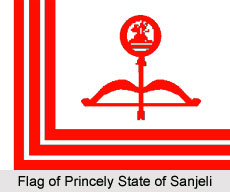 The Princely State of Sanjeli was one of the renowned states during the rule of the British Empire in India. During the early 19th century, the region was appointed as one of the princely states of India under the indirect rule of the British administration. The taluka was covered a total area of 34 sq miles and is a part of the Indian state of Gujarat. The region comprised of a total population of 8,083 in the year 1931. The native state of Sanjeli was located in the northeastern part of Gujarat and the territory included around 50 villages. It was under the administrative control of the erstwhile Rewa Kantha Agency. The region was bordered by the territory of Sant in the north; by the British territory of Panch Mahals in the east; by the state of Baria in the south; and by the district of Godhra in the British Panch Mahals in the west.
The Princely State of Sanjeli was one of the renowned states during the rule of the British Empire in India. During the early 19th century, the region was appointed as one of the princely states of India under the indirect rule of the British administration. The taluka was covered a total area of 34 sq miles and is a part of the Indian state of Gujarat. The region comprised of a total population of 8,083 in the year 1931. The native state of Sanjeli was located in the northeastern part of Gujarat and the territory included around 50 villages. It was under the administrative control of the erstwhile Rewa Kantha Agency. The region was bordered by the territory of Sant in the north; by the British territory of Panch Mahals in the east; by the state of Baria in the south; and by the district of Godhra in the British Panch Mahals in the west.
The erstwhile princely state of Sanjeli was incorporated as a part of the Baroda Agency, which was a sub division of the Western India States Agency. Later the region was merged with the state of Gujarat.
History of Princely State of Sanjeli
The native rulers of the princely state of Sanjeli held the title of Thakor. The Songada Chauhan Rajputs were the ruling family of the region. The family of Sanjeli was founded by Chhatrasal, who established the Rajpur Chhattisi kingdom. He and his successors held the northern districts of Baria from the frontiers of Sant to the Panam River. In the year 1804, with the intervention of the British East India Company, the native ruler of the state of Baria agreed to permit the Thakor of Sanjeli to keep almost 12 villages under his own authority and completely independent from Baria. The succession of the throne or gadi of the state was governed by the rule of male primogeniture, by which the first born or eldest child of the same parents to inherit the entire estate of one or both parents, to the exclusion of all others.
The Princely State of Sanjeli was a fifth class jurisdictionary state, before the class system was abolished in the year 1925. The native ruler took charge of the administration of the state, which lied in a state of decay. The native state of Sanjeli did not pay any annual tribute to any other Indian princely state of the British administration. The flag of Sanjeli state was rectangular and contained a white field which included 3 linings in the form of the letter L. It was placed so that there was a white bar along the hoist and 2 other L shaped white linings between the red linings. There was also a bow and arrow in the remaining space. Moreover there was a crown on the top of the arrow, in the middle of which a plant was placed with 5 leaves on a pedestal consisting of 2 steps. According to the Attachment Scheme of 1943, the princely state of Sanjeli was attached to the princely state of Baria.
On 15th August 1947 the nation attained freedom from the dominion of the British Government in India and it resulted in the partition of India. The former native states of India were given the option of merging with the newly formed Union of India or the Dominion of Pakistan. The last native ruler of the princely state of Sanjeli acceded his state to the Republic of India.
Rulers of Princely State of Sanjeli
The chronology of the native rulers or Thakors of the princely state of Sanjeli is mentioned below-
* Thakore Shri Pratapsinghji
* Thakore Shri Pushpasinghji Pratapsinghji
* Thakore Shri Narendra Singh
* Thakore Shri Manvendra Singh



















